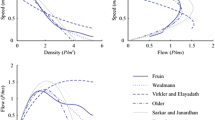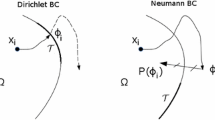Abstract
Pedestrian flow modelling has attracted the interest of a large number of scientists from different research fields, as well as planners and designers. While planning the architecture of buildings, one might be interested in the pedestrian flow around their intended design so that shops, entrances, corridors, emergency exits and seating can be placed at the best locations. Pedestrian models are helpful in improving efficiency and safety in public places such as airport terminals, train stations, theatres and shopping malls. They are not only used as a tool for understanding pedestrian dynamics at public places but also support transportation planners or managers to design timetables.
Access this chapter
Tax calculation will be finalised at checkout
Purchases are for personal use only
Similar content being viewed by others
References
D. Amadoria, M. Di Francesco, The one-dimensional Hughes model for pedestrian flow: Riemann-type solutions, Acta Mathematica Scientia, 32 (2012) 259–280.
A. Aw and M. Rascle, Resurrection of second order models of traffic flow, SIAM J. Appl. Math., 60 (2000), pp. 916–938.
N. Bellomo, C. Dogbe, On the Modeling of Traffic and Crowds: A Survey of Models, Speculations, and Perspectives, SIAM Review 53 (2011) 409–463.
N. Bellomo, A. Bellouquid, On the modeling of crowd dynamics: Looking at the beautiful shapes of swarms, Netw. Heterog. Media, 6 (2011) 383–99.
N. Bellomo, A. Bellouquid, D. Knopoff, From the microscale to collective crowd dynamics, SIAM J. Multiscale Model. Simul. 11 (2013) 943–963.
N. Bellomo, C. Dogbe, On the modelling crowd dynamics from scaling to hyperbolic macroscopic models, Math. Models Methods Appl. Sci. 18 (2008) 1317–1345.
N. Bellomo, B. Piccoli, A. Tosin, Modeling crowd dynamics from a complex system viewpoint, Math. Models Methods Appl. Sci. 22 (2012) 1230004.
T. Belytschko, Y. Guo, W. Liu, S.P. Xiao, A unified stability analysis of meshless particle methods, Int. J. Numer. Meth. Engng. 48 (2000) 1359–1400.
R. Borsche, A. Klar, S. Kühn, A. Meurer, Coupling traffic flow networks to pedestrian motion, Math. Methods Models Appl. Sci. 24 (2), 359–380, 2014
T. Brunner, Forms of approximate radiation transport, SAND2002-1778, Sandia National Laboratory
J.A. Cañizo, J.A. Carrillo, J. Rosado, A well-posedness theory in measures for some kinetic models of collective motion, Math. Models Methods Appl. Sci. 21 (2011) 515–539.
J.A. Carrillo, M.R. D’Orsogna, V. Panferov, Double milling in self-propelled swarms from kinetic theory, Kinetic and Related Models 2 (2009) 363–378.
J. A. Carrillo, A. Klar, S. Martin, S. Tiwari, Self-propelled interacting particle systems with roosting force, Math. Models Methods Appl. Sci. 20 (2010) 1533–1552.
L. Cheng, V. Reddy, C. Fookes, and P. K. D. V. Yarlagadda, Impact of passenger group dynamics on an airport evacuation process using an agent-based model, International Conference on Computational Science and Computational Intelligence, Las Vegas, Nevada, USA (2014).
M.L. Chu, P. Parigi, K. Law, J.-C. Latombe, Modeling social behaviors in an evacuation simulator, Computer animation and virtual worlds, Comp. Anim. Virtual Worlds 2014; 25:375–384
Y.L. Chuang, M.R. D’Orsogna, D. Marthaler, A.L. Bertozzi, L. Chayes, State transitions and the continuum limit for a 2D interacting, self-propelled particle system, Physica D 232 (2007) 33–47.
R. Colombo, M. Garavello, M. Lecureux-Mercier, A Class of Non-Local Models for Pedestrian Traffic, Math. Models Methods Appl. Sci. 22 (2012) 1150023.
R. Colombo, M. Garavello, M. Lecureux-Mercier, Non-local crowd dynamics, Comptes Rendus Mathmatique 349 (2011) 769–772.
R. Colombo, M. Rosini, Pedestrian flows and non-classical shocks, Math. Models Methods Appl. Sci. 28 (2005) 1553–1567.
J.F. Coulombel, F. Golse, T. Goudon, Diffusion approximation and entropy based moment closure for kinetic equations, Asymptotic Analysis, 45 (2005) 1–39.
P. Degond, C. Appert-Rolland, M. Moussaid, J. Pettre, G. Theraulaz, A hierarchy of heuristic-based models of crowd dynamics, J. Stat. Phys. 152 (2013) 1033–1068.
P. Degond, C. Appert-Rolland, J. Pettre, G. Theraulaz, Vision-based macroscopic pedestrian models, Kinetic and Related models, AIMS 6, 4, (2013), 809–839
P. Degond, S. Motsch, Continuum limit of self-driven particles with orientation interaction, Math. Models Methods Appl. Sci. 18 (2008) 1193–1215.
P. Degond, F.J. Mustieles, Approximation of diffusion equations by deterministic convections of particles, SIAM J. on Scientific and Statistical Computing 11 (1990) 293–310.
G.A. Dilts, Moving-least-squares-particle hydrodynamics: I. Consistency and stability, Int. J. Numer. Meth. Engng 44 (1999) 1115–1155.
R Etikyala, S Göttlich, A Klar, and S Tiwari. Particle methods for pedestrian flow models: From microscopic to nonlocal continuum models. Mathematical Models and Methods in Applied Sciences, 20(12), 2503–2523, 2014.
M. Di Francesco, P.A. Markowich, J.F. Pietschmann, M.T. Wolfram, On the Hughes model for pedestrian flow: The one-dimensional case, J. Differential Equations 250 (2011) 1334–1362.
R.A. Gingold, J.J. Monaghan, Smoothed Particle Hydrodynamics: theory and application to non-spherical stars, Mon. Not. Roy. Astron. Soc. 181 (1977) 375–389.
M. Frank, H. Hensel, A. Klar, A fast and accurate moment method for the Fokker-Planck equation and applications to electron radiotherapy, SIAM Journal on Applied Mathematics 67, 582–603, 2007
S.Y. Ha, E. Tadmor, From particle to kinetic and hydrodynamic descriptions of flocking, Kinetic and Related Models 1 (2008) 415–435.
E.T., Hall, The Hidden Dimension. Anchor Books. ISBN 0-385-08476-5, 1966.
D. Helbing, Traffic and related self-driven many-particle systems, Rev. Modern Phys. 73 (2001) 1067–1141.
D. Helbing, A fluid dynamic model for the movement of pedestrians, Complex Systems 6 (1992) 391–415.
D. Helbing, P. Molnar, Social force model for pedestrian dynamics, Phys. Rev. E 51 (1995) 4282–4286.
D. Helbing, I.J. Farkas, P. Molnar, T. Vicsek, Simulation of pedestrian crowds in normal and evacuation situations, in: M. Schreckenberg, S.D. Sharma (Eds.), Pedestrian and Evacuation Dynamics, Springer-Verlag (2002) 21–58.
R.L. Hughes, A continuum theory for the flow of pedestrians, Transp. Res. Part B: Methodological 36 (6) (2002), pp. 507–535.
R.L. Hughes, A continuum theory for the flow of pedestrians, Transp. Res. Part B: Methodological 36 (2002) 507–535.
R.L. Hughes, The flow of human crowds, Annu. Rev. Fluid Mech. 35 (2003) 169–182.
D.P. Kennedy, J. Gläscher, J.M. Tyszka, R. Adolphs, Personal space regulation by the human amygdala. Nat Neurosci. 12, 1226–1227, 2009.
C. v. Krüchten, A. Schadschneider, Empirical study on social groups in pedestrian evacuation dynamics, Physica A 475 (2017) 129–141
A. Klar, F. Schneider, O. Tse, Maximum entropy models for stochastic dynamic systems on the sphere and associated Fokker-Planck equations, Kinetic and Related Models (KRM) 7 (3), 509–529, 2014
A. Klar, S. Tiwari, A multi-scale meshfree particle method for macroscopic mean field interacting particle models, SIAM Multiscale Mod. Sim. 12, 3, 2014
A. Klar, S. Tiwari, A multi-scale particle method for mean field equations: the general case, https://arxiv.org/abs/1705.03324
G. Koester, F. Treml, M. Seitz, and W. Klein, Validation of crowd models including social groups. In Ulrich Weidmann, Uwe Kirsch, and Michael Schreckenberg, editors, Pedestrian and Evacuation Dynamics 2012, 1051–1063. Springer International Publishing, 2014.
A.E. Kremyzas, Social Group Behavior and Path Planning, Master Thesis, University Utrecht
C.D. Levermore, Relating Eddington factors to flux limiters, J. Quant. Spectrosc. Radiat. Transf. 31 (1984) 149–160.
H. Ling, S.C. Wong, M. Zhang, C.H. Shu, W.H.K. Lam, Revisiting Hughes dynamic continuum model for pedestrian flow and the development of an efficient solution algorithm, Transp. Res. Part B: Methodological 43 (2009) 127–141.
N.K. Mahato, A. Klar, S. Tiwari, Particle methods for multi-group pedestrian flow, Appl. Math. Modeling 53, 447–461, 2018
S. Mas-Gallic, P. Raviart, A particle method for first-order symmetric systems, Numerische Mathematik 51 (1987) 323–352.
B. Maury, A. Roudneff-Chupin, F. Santambrogio, A macroscopic crowd motion model of the gradient-flow type, Math. Models Methods Appl. Sci. 20 (2010) 1787–1821.
L. Müller, A. Meurer, F. Schneider, A. Klar, A numerical investigation of flux-limited approximations for pedestrian dynamics, M3AS 27 (6), 1177–1197, 2017
A. Mogilner, L. Edelstein-Keshet, L. Bent, A. Spiros, Mutual interactions, potentials, and individual distance in a social aggregation, J. Math. Biol. 47 (2003) 353–389.
M. Moussaid, N. Perozo, S. Garnier, D. Helbing, and G. Theraulaz, Walking Behaviour of Pedestrian Social Groups and Its Impact on Crowd Dynamics, PLoS ONE, 5(4), e10047(2010).
S. Osher and J. Sethian, Fronts propagating with curvature-dependent speed: Algorithms based on Hamilton–Jacobi formulations, J. Comput. Phys. 79 (1988) 12–49.
J. Ondrej, J. Pettre, A.H. Olivier, S. Donikian, A synthetic-vision based steering approach for crowd simulation, ACM Transactions on Graphics, 29, 4, Article 123 (2010)
B. Piccoli, A. Tosin, Pedestrian flows in bounded domains with obstacles, Contin. Mech. Thermodyn. 21 (2009) 85–107.
F. Schneider, G. Alldredge, M. Frank, A. Klar, Higher Order Mixed-Moment Approximations for the Fokker–Planck Equation in One Space Dimension, SIAM Journal on Applied Mathematics 74 (4), 1087–1114, 2014
H. Spohn, Large scale dynamics of interacting particles. Texts and Monographs in Physics, Springer (1991).
J. A. Sethian, Fast Marching Methods, SIAM Review 41 (1999) 199–235.
S. Tiwari, J. Kuhnert, Modelling of two-phase flow with surface tension by Finite Point-set method (FPM), J. Comp. Appl. Math. 203 (2007) 376–386.
S. Tiwari, J. Kuhnert, Finite pointset method based on the projection method for simulations of the incompressible Navier-Stokes equations, M. Griebel, M. A. Schweitzer (Eds.), Springer LNCSE: Meshfree Methods for Partial Differential Equations, Springer-Verlag 26 (2003) 373–387.
S. Tiwari, A. Klar, S. Hardt, A particle-particle hybrid method for kinetic and continuum equations, JCP 228 (2009) 7109–7124.
E. Toro, Riemann Solvers and Numerical Methods for Fluid Dynamics: A Practical Introduction (Springer, 2009).
A. Treuille, S. Cooper, Z. Popovic, Continuum crowds, in: ACM Transaction on Graphics, Proceedings of SCM SIGGRAPH 25 (2006) 1160–1168.
J. Xi, X. Zou, Z. Chen, J. Huang, Multi-pattern of Complex Social Pedestrian Groups Transportation Research Procedia Volume 2, 2014, 60–68
H.P. Zhu, A.B. Yu, Averaging method of granular materials, Phys. Rev. E 66 (2002) 021302.
Acknowledgements
This work is supported by the German Research Foundation, DFG grant KL 1105/20-1, and by the DAAD PhD programme MIC.
Author information
Authors and Affiliations
Corresponding author
Editor information
Editors and Affiliations
Rights and permissions
Copyright information
© 2018 Springer Nature Switzerland AG
About this chapter
Cite this chapter
Borsche, R., Klar, A., Schneider, F. (2018). Numerical Methods for Mean-Field and Moment Models for Pedestrian Flow. In: Gibelli, L., Bellomo, N. (eds) Crowd Dynamics, Volume 1. Modeling and Simulation in Science, Engineering and Technology. Birkhäuser, Cham. https://doi.org/10.1007/978-3-030-05129-7_7
Download citation
DOI: https://doi.org/10.1007/978-3-030-05129-7_7
Published:
Publisher Name: Birkhäuser, Cham
Print ISBN: 978-3-030-05128-0
Online ISBN: 978-3-030-05129-7
eBook Packages: Mathematics and StatisticsMathematics and Statistics (R0)




